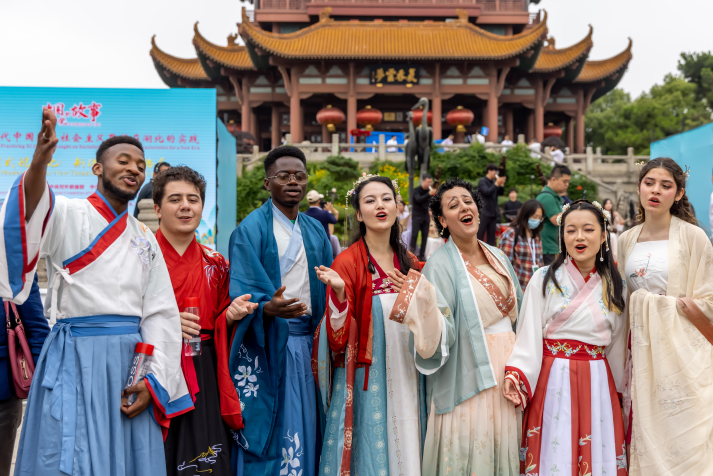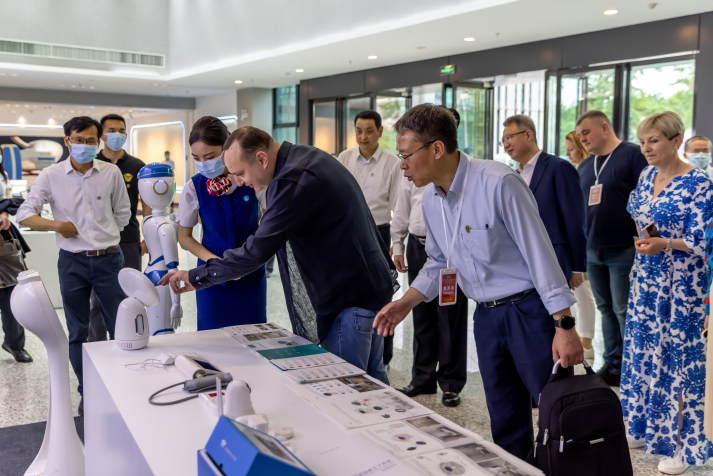| World |
| Visit to central China helps foreign political party representatives better understand Chinese modernization | |
|
|
 People from multiple countries gather in front of the Yellow Crane Tower in Wuhan, Hubei Province, on May 30 (COURTESY PHOTO)
The sage on the yellow crane was gone amid cloud white. To what avail is the Yellow Crane Tower left here? —Excerpts from Yellow Crane Tower by Cui Hao (704-754) The poem Yellow Crane Tower is an iconic work about Wuhan's most iconic building, recited by generations of locals and visitors to the capital of Hubei Province in central China. Celebrated in nearly 1,500 poems, the imposing structure is considered the symbol of the city. Standing on the bank of the Yangtze River, it has witnessed the city's ups and downs for 1,800 years. The sweeping curvature of the tower's many yellow-tiled eaves was designed to resemble a crane spreading its wings to take flight. On May 30, over 170 representatives from 36 political parties in 28 countries gathered at and ascended the Yellow Crane Tower. In cool breezes, they looked out over the Yangtze flowing to the east; over Wuhan, with its skyscrapers and neighborhoods of local architecture, and over lakes, trees and streams of traffic. This was the start of their journey through Hubei, an exploration of Chinese modernization. Their six-day visit was jointly hosted by the International Department of the Central Committee of the Communist Party of China (CPC) and the CPC Hubei Provincial Committee. The visit was the 15th of its kind since the International Department of the CPC Central Committee initiated a program in 2017 to enhance the understanding of the CPC among foreign dignitaries and politicians. Known as Stories of the CPC, the series organizes representatives from political parties in different countries to visit places across China to see local development and how regional CPC committees implement the Party's governance philosophy. Proposed at the 20th CPC National Congress in Beijing last October, Chinese modernization is defined as the modernization of a huge population, of common prosperity for all, of material and cultural-ethical advancement, of harmony between humanity and nature and of peaceful development. "Modernization has long been a shared goal of countries worldwide and a common pursuit of all peoples. Political parties and peoples in different countries have found their own paths to modernization with distinctive features based on their own realities," Liu Jianchao, Minister of the International Department of the CPC Central Committee, said at an event during the visit on May 30. Chinese modernization is an important part of the global modernization process. The CPC will continue to create new opportunities for the world through China's development and will share its best practices and experiences with other developing countries, Liu added.  Representatives of foreign political parties visit the Wuhan National Laboratory for Optoelectronics at Huazhong University of Science and Technology in Wuhan on May 30 (COURTESY PHOTO)
Hubei's version of China's vision The tour of Hubei, titled Chinese Modernization: New Thinking to Break New Ground, was the first large-scale in-person exchange between international political parties China had hosted since the onset of the COVID-19 pandemic in early 2020. Located in the middle reaches of the Yangtze, Hubei plays a significant role in the development of central China and the Yangtze River Economic Belt, which consists of 11 provinces and municipalities along the country's longest waterway. As one of the country's main transportation hubs, it is also an economic, scientific, ecological and agricultural powerhouse. "We have implemented the new development philosophy [that prioritizes innovation, coordination, green development, openness, and sharing] and promoted people-centered modernization over the past decade," Wang Menghui, Secretary of the CPC Hubei Provincial Committee, said at the event. The foreign political party representatives visited the Wuhan National Laboratory for Optoelectronics at Huazhong University of Science and Technology. One of China's six national-level research centers, the institution focuses on basic research in the fields of optoelectronics (light-emitting and detecting devices) for information, energy and life sciences. In recent years, it has achieved fruitful results in fields including brain imaging, solar cells, ultrafast lasers, optoelectronic devices and integration, and data storage. Pablo Inzunza, a professor of civil and electrical engineering at the University of Santiago, Chile, told Beijing Review that advanced technologies developed in China can be applied to development around the world as many countries and regions share similar problems. Automobile manufacturing is an important pillar industry of Hubei; the industry's revenue reached 700 billion yuan ($98.3 billion) last year. Xiangyang Tenglong Automobile Co. Ltd. in the city of Xiangyang, the province's auto production hub, exports its products to India, Peru, Egypt and the Republic of Korea. Instead of laying tracks on the road, the company's intelligent electric tram runs along virtual tracks and identifies invisible lines with various sensors. "I see the strength of the automobile industry in Xiangyang, which features increasing scientific and technological innovation and new energy utilization," Génesis Garvett, a member of the National Assembly of Venezuela, said, adding that the details of the products that cater to people with disabilities impressed her most. She believes environment-friendly new-energy vehicles represent the direction of future development and Xiangyang's experience is worth learning from. Ecological protection Yichang, the second largest city in Hubei, is just 40 km from the Three Gorges Dam. Many people from China and abroad pass through the city on their way to go see the world's largest hydropower station. An hour's drive from the Three Gorges Dam, on the northern bank of the Yangtze is Hubei Xingfa Chemicals Group Co. Ltd. Established in 1994, it is a manufacturer of phosphorus-based chemicals. In recent years, the company has invested 1.2 billion yuan ($168.5 million) in waste water recycling and the ecological restoration of the nearby Yangtze section. At the same time, by teaming up with the Chinese Academy of Sciences, it has also developed new products with little environmental impact. The company's progress is part of Yichang's campaign to better regulate chemical plants along the river. As the area is rich in phosphates and water, and close to river transport, the production of chemicals used to account for nearly one third of the local industrial output value, which resulted in severe environmental problems. From 2017 to 2020, the city closed over 30 companies that failed to meet environmental standards and supported the upgrade of 100 companies with lower environmental risks. "Shutting down polluting factories along the river, repairing the Yangtze shoreline and transforming other industries, all this demonstrates the courage and determination of the city," Onwuama Udenta Udenta, a senior research fellow with the Nigerian Center for China Studies, said. Clean water and lush mountains in Hubei also inspired the delegation from Mongolia. Danjiangkou Reservoir in Shiyan is the starting point of the middle route of the South-to-North Water Diversion Project that runs across Henan and Hebei provinces before reaching Beijing and Tianjin. It began supplying water on December 12, 2014, and has since directly benefited roughly 80 million people in large and medium-sized cities along its route. Today, the city is relying on its ample high-quality water and has formed a complete industrial chain for the processing of drinking water with the participation of many beverage companies. The city plans to have established an industrial cluster with an output value of 15 billion yuan ($2.1 billion) by 2026. A. Tserenbat, a member of the National Policy Committee of the Mongolian Democratic Party, said that despite Mongolia having many rivers and reservoirs, these are only used to generate electricity. "We can bring China's modern processing methods back to Mongolia so our water resources can create more value and develop into an industrial cluster," he said. (Printed Edition Title: Nice to Meet You, Hubei) Copyedited by G.P. Wilson Comments to liqing@cicgamericas.com |
|
||||||||||||||||||||||||||||||
|